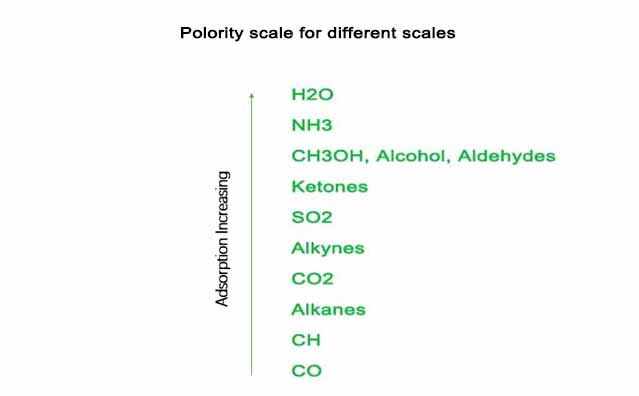ProductAll categories
Faq
Zeolite molecular sieve is a aluminosiliate with uniform pores. These pore diameters are similar in size to small molecules. Thus molecules with diameter less than the pore size can enter molecular sieve and be adsorbed, while molecules with diameter bigger than the pore size can not go into molecular sieve and be excluded (Tab. 1). Moreover, molecular sieve pore size can be precisely adjusted through introducing of different metal ions such as Na+(4A, 13X), K+(3A), Ca+(5A, CaX), Li+(LiLSX, LiLX). This property enables molecular sieve to separate molecules of different size. Another important property of molecular sieve is it is easier to adsorb polar molecules other than non polar molecules, thus makes it possible to separate molecules by its polarity (Fig. 1).
Tab.1 pore size of different kinds of molecules
| Molecules | Critical Diameter in Å |
| Helium | 2 |
| Hydrogen, Acetylene | 2.4 |
| Water, O2, Monoxide and Dioxide | 2.8 |
| Nitrogen | 3 |
| Ammonia, Hydrogen Sulphide | 3.6 |
| Argon | 3.8 |
| Methane | 4 |
| Ethylene, Ethylene monoxide | 4.2 |
| Ethane, Methanol, Ethanol | 4.4 |
| Methyl-mercaptan | 4.5 |
| Propane, nC4 to nC22 | 4.9 |
| Propynene | 5 |
| Ethyl-RH, Butene 1, Butene 2 trans | 5.1 |
| Difluochloromethane (R22) | 5.3 |
| ISO C22 | 5.6 |
| Cyclohexane | 6.1 |
| Toluene, Paraxylene | 6.7 |
| Benzene | 6.8 |
| Carbon tetrachloride | 6.9 |
| Metaxylene | 7.1 |
| Tri-ethylamine | 8.4 |

Molecular Sieve Application
| Type | Pore Size | Application |
| 3A | 3Å | 1. Drying of unsaturated hydrocarbons 2. Cracked gas drying 3.Drying of natural gas, if COS minimization is essential, or a minimum co-adsorption of hydrocarbons is required 4. Drying of highly polar compounds, such as methanol and ethanol |
| 4A | 4Å | 1. Drying and removing of CO2 from natural gas, LPG, air, inert and atmospheric gases, etc 2. Removal of hydrocarbons, ammonia and methanol from gas streams (ammonia syn gas treating) 3. Dehydration of refrigerant and air in the air break units of buses, trucks and locomotives 4. Packed in small bags for packing desiccant for foods, etc |
| 5A | 5Å | 1. The strong ionic forces of the divalent calcium ion makes it an excellent adsorbent to remove water, CO2, H2S from sour natural gas streams, while decreasing COS formation. It can also adsorbs light mercaptans. 2. It is also used for the separation of normal- and iso-paraffins 3. Production of high purity N2, O2, H2 and inert gases from mixed gas streams 4. PSA hydrogen purification |
| 13X | 10Å | 1. Removal of CO2 and moisture from air (air pre-purification) and other gases 2. Separation of enriched oxygen from air 3. Removal of mercaptans and hydrpogen sulphide from hydrocarbon liquid streams such as LPG, butane, propane etc 4. Catalyst protection, removal of oxygenates from hydrocarbons (olefin streams) 5. Removal of n-chained compositions from aromatics |
| JLOX-500 | 10Å | 1. JLOX-501 with smaller beads is degined for small medical oxygen concentrator 2. JLOX-500 is desinged for bigger industrial or medical oxygen concentrators smaller than 200 Nm3/h |
| JLOX-100 | 10Å | 1. JLOX-101 with smaller beads is degined for small medical oxygen concentrator; 2. JLOX-102, JLOX-103 is desinged for bigger industrial or medical oxygen concentrators larger than 200 Nm3/h |
